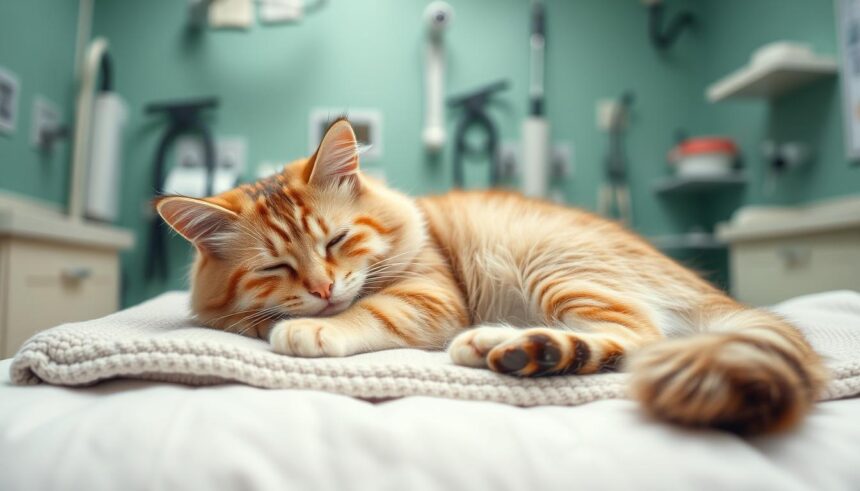Spaying a cat can greatly lower the risk of mammary cancer. This risk jumps after a cat’s first heat cycle, which can start as early as 4 months. This shows why it’s key to spay cats young to avoid health problems. Spaying removes a female cat’s ovaries and uterus, a big surgery needing general anesthesia.
Key Takeaways
- Spaying a cat can reduce the risk of certain diseases, such as uterine infections and breast cancer.
- The ideal time for spaying a cat is before the first heat cycle, which can occur as early as 4 months of age.
- Spaying a cat can prevent unwanted litters and reduce the risk of certain health issues.
- The cost of spaying a cat typically ranges from $50 to several hundred dollars.
- Recovery time after spaying usually lasts between 10 to 14 days, during which pain medications are typically prescribed.
- It is essential to monitor the incision site for symptoms such as excess redness, swelling, discharge, or gaps, and to follow the veterinarian’s instructions for post-operative care.
- Some veterinary clinics and animal shelters offer low-cost cat spay services, making it more accessible for cat owners to spay their pets.
What is Cat Spaying?
Cat spaying, also known as ovariohysterectomy, is a surgery that stops a cat from having kittens. It removes the ovaries and uterus. This helps prevent unwanted litters and lowers disease risks. The feline spay procedure also stops heat cycles and lowers the chance of uterine infections and breast cancer.
Spaying is crucial for a cat’s health. The ASPCA says it can cut unwanted kittens by up to 87% and pet homelessness by up to 50%. It also makes cats live longer. Some key benefits of feline spay include:
- Reduced risk of certain diseases, such as uterine infections and breast cancer
- Prevention of unwanted litters and pet overpopulation
- Decreased roaming behaviors in male cats
- Reduced risk of testicular cancer and benign prostatic hyperplasia in male cats
It’s important to talk to a vet to find the right time for pet spay surgery. The best age varies by breed, size, and health. Spaying or neutering helps reduce shelter animals and improves your cat’s health and happiness.
| Procedure | Cost | Benefits |
|---|---|---|
| Feline spay | $50-$250 | Reduced risk of certain diseases, prevention of unwanted litters |
| Neutering | $50-$150 | Reduced roaming behaviors, decreased risk of testicular cancer |
Benefits of Spaying Your Cat
Spaying your cat can greatly improve their health and happiness. Choosing veterinary spay services can lower the risk of diseases like uterine infections and breast cancer. Spaying before the first heat can prevent these issues, especially uterine infections and breast tumors.
Some of the key benefits of spaying your cat include:
- Reduced risk of certain diseases, such as uterine infections and breast cancer
- Prevention of unwanted litters and population control
- Reduced behavioral issues, such as spraying or roaming
Also, spaying pets makes your home cleaner. It stops male cats from spraying urine and female cats from leaking fluids when in heat. It’s best to spay female cats before they hit puberty, around 5 months old. This stops unwanted spraying and pregnancies.
In summary, spaying your cat is a smart choice. It leads to a healthier, happier life for your pet. By choosing veterinary spay services, you’re making a big difference in your cat’s well-being.
When to Spay Your Cat
Deciding when to spay a cat is key to stopping cat overpopulation and health risks. Vets say spaying should happen between 4 and 6 months, before they hit puberty. This age is critical for cat population control and cuts down stray cat numbers.
Spaying a female cat before her first heat cycle lowers the risk of cancer. It also stops behaviors like loud howling and wandering. In just seven years, one cat and her kittens can have 420,000 offspring, adding to the cat overpopulation problem.
Spaying or neutering cats at the right time is vital for cat population control. It brings health benefits, better behavior, and stops unwanted litters. By doing this, we can lower stray cat numbers and fight cat overpopulation.
| Age | Benefits of Spaying |
|---|---|
| 4-6 months | Reduces risk of malignant mammary tumors, eliminates certain behaviors |
| Before first heat cycle | Prevents unwanted litters, reduces risk of certain diseases |
The Spaying Procedure
When thinking about cat spay surgery, it’s key to know what happens. The spaying process removes the cat’s ovaries and uterus. This is done under general anesthesia to keep the cat safe and comfortable.
The spaying cats process is usually simple. Most cats go home within 12 to 24 hours after surgery. It’s important to follow the vet’s care instructions to avoid problems. This includes watching for signs of infection and keeping the cat from licking or biting the incision.
Cats need a few days to rest and recover after spaying. They need a calm place, easy-to-reach food and water, and no strenuous activities. By following the vet’s advice and caring for the cat, owners can help them heal well.
Potential Risks and Complications
When thinking about spaying your cat or pet, knowing the risks is key. The procedure is usually safe, but there are possible side effects to watch out for.
Common side effects include pain, swelling, and discharge from the incision. In rare cases, serious complications like infection, bleeding, or reactions to anesthesia can happen.
A study on pet spay procedures shows the risk of complications is low. For example, the chance of anesthetic complications leading to death is about 1 in 2500 animals. Other risks include hernias, infections, and bleeding during or after surgery.
- Infection or bleeding at the incision site
- Adverse reactions to anesthesia
- Hernias or other complications during surgery
Talking to a vet about these risks is important. This way, you can decide what’s best for your pet’s health. Regular check-ups and follow-up care can help avoid complications and ensure your pet recovers well.
Cost of Cat Spay Surgery
When it comes to spaying pets, cat owners need to think about the cost. The average price to spay a cat is between $150 and $300. This price can change based on the cat’s age, size, and health, as well as the vet’s fees and any extra services.
Several things can impact the cost of veterinary spay services. These include:
- Cat’s age and size
- Health status
- Location and veterinarian’s fees
- Additional procedures or services
The cost of spaying pets can really vary. It can be as low as $50 or as high as $500. Spaying pets is key to being a responsible pet owner. It’s important to think about the cost and find a good vet to do the job.
To learn more about spaying costs and veterinary spay services, talk to a vet or check out a site like Pawlicy.
| Location | Cost |
|---|---|
| Private veterinarian | $200-$400 |
| Lower-cost clinics | less than $100 |
Finding a Veterinary Clinic
Finding the right vet for your cat’s spaying is key. Cat overpopulation is a big problem, and spaying helps control it. Start by asking friends and family for vet recommendations. About 62% of pet owners trust these referrals.
Local animal shelters and rescue groups also have vet lists. Online reviews can help, but only 36% of pet owners trust them. Look at clinic hours, services, and costs. About 70% of vets offer weekend or evening hours, and 25% do special surgeries.
Ask about anesthesia, risks, and recovery. Researching and choosing a good vet helps control cat numbers. It also ensures your pet gets the best care.
| Clinic Services | Percentage of Clinics Offering |
|---|---|
| Saturday and/or evening appointments | 70% |
| Specialized services (behavior counseling, orthopedic surgeries) | 25% |
| Pet insurance acceptance | 55% |
Preparing for the Spay Surgery
As the spay surgery day gets closer, it’s key to get your cat ready. Spaying cats is common and has many health benefits. Getting your cat ready right is important for a good outcome.
Vets say pets should not eat after midnight the night before surgery. This is a big step in getting your cat ready for the spay. It helps avoid problems with anesthesia.
Pre-Operative Instructions
To get your cat ready for the spay, follow these steps:
- Don’t feed or water your cat for a while before the surgery
- Keep the area calm and quiet
- Give your cat a familiar blanket or toy
Preparing Your Cat for a Stress-Free Experience
It’s also important to make your cat’s experience stress-free. You can do this by:
- Creating a calm and comfy space
- Reducing noise and stress
- Helping your cat get used to the carrier or how they’ll get there
By following these tips and getting your cat ready for the spay, you can help them have a good surgery and recovery. Always talk to your vet for specific advice on spaying cats.
Aftercare for Your Spayed Cat
After a feline spay, it’s key to take good care of your cat. This means watching the incision, giving pain meds, and keeping them calm. Veterinary guidelines say cats need 7-10 days to recover.
Important steps for aftercare include:
- Check the incision daily for infection signs like bleeding, redness, or swelling.
- Keep your cat quiet and still for two weeks to avoid jumping or climbing.
- Give them a cozy, quiet spot to rest without other pets or people.
Following your vet’s care instructions is vital. It helps your cat heal well and quickly after a spay.
If you see any complications like bleeding or swelling, get vet help fast. With the right care, your cat will recover fully and live a happy life.
Spaying vs. Neutering: What’s the Difference?
Many pet owners are confused about spaying pets. Spaying and neutering are both surgeries that stop pets from having babies. But they are not the same. Spaying removes ovaries and the uterus in females. Neutering removes testes in males.
Choosing between spaying and neutering depends on the cat’s sex, age, and health. It also depends on the owner’s lifestyle and preferences. Spaying pets can prevent diseases like uterine infections and unwanted litters. Neutering can stop male cats from roaming and fighting.
Here are some key differences between spaying and neutering:
- Spaying: removal of ovaries and uterus in female animals
- Neutering: removal of testes in male animals
- Spaying: can help reduce risk of uterine infections and prevent unwanted pregnancies
- Neutering: can help reduce roaming and fighting behaviors in male cats
The cost of veterinary spay procedures varies. It depends on the pet’s weight, size, and sex. But, spaying and neutering are cheaper than treating illnesses caused by not spaying or neutering.
| Procedure | Benefits | Risks |
|---|---|---|
| Spaying | Reduces risk of uterine infections, prevents unwanted pregnancies | Infections, anesthesia-related risks |
| Neutering | Reduces roaming and fighting behaviors, prevents testicular cancer | Infections, anesthesia-related risks |
In conclusion, spaying and neutering are both crucial for pet owners. They have different benefits and risks. Knowing these differences helps owners choose the best option for their cat.
Myths About Cat Spaying
Many people think spaying a cat makes it fat or lazy. But, this is just a myth. Spaying actually helps prevent health issues like uterine infections and breast cancer. This helps control the cat population.
Some think spaying is too expensive. But, it’s a one-time cost that can be as low as $25 to $50. It stops cat overpopulation by reducing unwanted litters. One cat can have up to 420,000 kittens in seven years if not spayed.
It’s key to teach cat owners about spaying’s benefits. This way, we can encourage responsible pet care. It also helps lower the number of cats in shelters. Here are some important facts about cat spaying:
- Cats can get pregnant as young as 4 months.
- Kittens can be spayed or neutered when they weigh 2 pounds, usually around 8 weeks old.
- Spaying stops uterine infections and breast tumors in female cats.
Knowing the truth about cat spaying helps us tackle cat overpopulation. It makes our community better for cats and their owners. This leads to a healthier, happier place for everyone, achieving effective cat population control.
Community Resources for Spaying
Many cat owners worry about the cost of spaying their pets. Luckily, there are community resources to help. Organizations offer low-cost spay programs. This makes it easier for owners to spay their cats.
These programs often have discounted rates. They also provide free or low-cost services for those who can’t afford it.
For example, the Spay/Neuter Resource Map helps find spay and neuter services. It lists low-cost clinics, voucher programs, and mobile clinics. Many vets also offer low-cost spay and neuter services through local directories.
Veterinary colleges and low-cost animal clinics are other resources. They provide spay and neuter services, vaccinations, and wellness care. These clinics open in communities to help pets and their owners.
Here’s how to find these resources:
- Check online directories for low-cost spay and neuter services
- Contact local animal shelters or veterinary colleges for information on low-cost spay programs
- Look for community fundraising events, such as bake sales or garage sales, that support Trap-Neuter-Return (TNR) initiatives
By using these resources, cat owners can afford to spay their pets. This helps reduce unwanted litters in the community.
| Resource | Description |
|---|---|
| Spay/Neuter Resource Map | A map that connects organizations and individuals with spay and neuter resources |
| Low-cost clinics | Physical locations that perform spay and neuter surgeries at a discounted rate |
| Voucher/assistance programs | Programs that offer financial support for spaying and neutering at partner facilities |
Spaying and Cat Behavior
Spaying can change a cat’s behavior a lot. It makes them less aggressive and less likely to wander off. After a feline spay, cats often stop fighting with other cats. This makes homes more peaceful, especially for those with many cats.
Spaying also helps with cats spraying or marking places. Consistency and patience are important here. It takes time to fix these issues. Knowing how spaying affects cats helps owners manage their pets better.
- Reduced aggression and roaming
- Decreased spraying or marking territory
- Less vocalization, especially in female cats
These changes can make the bond between cats and their owners stronger. It shows why spaying is a good choice for cat owners.
The Impact of Spaying on Feline Health
Spaying pets, especially cats, greatly affects their health and happiness. Studies show it lowers the risk of diseases like uterine infections and breast cancer. This is because the spaying procedure removes organs that can get sick.
A veterinary spay also makes spayed cats live longer and healthier. It cuts down on health problems and behavioral issues caused by hormones. This is true for both male and female cats.
Some key benefits of spaying pets include:
- Reduced risk of certain diseases, such as uterine infections and breast cancer
- Improved long-term welfare and increased lifespan
- Decreased likelihood of behavioral issues linked to hormonal urges
It’s crucial to talk to a vet to find the right time for spaying. This depends on the cat’s age, health, and needs. Spaying helps keep pets healthy and happy, and lowers the chance of some health issues.
| Benefits of Spaying | Description |
|---|---|
| Reduced risk of disease | Spaying can reduce the risk of certain diseases, such as uterine infections and breast cancer |
| Improved long-term welfare | Spaying can improve the long-term welfare of spayed cats, increasing their lifespan and overall health |
Frequently Asked Questions About Spaying
Many cat owners wonder about the best time to spay their pets. They also ask about the risks and how it might change their cat’s behavior. Knowing the answers can help ease worries and guide owners in making the right choice. Spaying is a key method to manage cat overpopulation and stop unwanted litters.
Some common questions about spaying include:
- What is the best age to spay a cat?
- What are the potential risks and complications?
- How will spaying affect my cat’s behavior?
Spaying can lower the risk of health issues like mammary tumors and pyometra. It also helps control cat population control by stopping unwanted litters. By spaying your cat, you help reduce shelter populations and tackle cat overpopulation.
It’s crucial to talk to a vet to find the best spaying time for your cat. They can address any concerns you have. Together, we can lessen unwanted litters and positively impact cat population control efforts.
Conclusion: The Importance of Spaying
Spaying is key for any pet owner. It greatly improves your cat’s health and happiness. It lowers the risk of diseases like uterine and ovarian cancers. It also stops unwanted litters and helps fight cat overpopulation.
Spaying does more than just keep your cat healthy. It can also change their behavior for the better. Spayed cats are less likely to wander off, mark territory, or fight. This makes your relationship with your cat much better.
Choosing to spay your cat is a smart move. It has many benefits that last a long time. With affordable spay programs and mobile vet services, it’s easier than ever. By spaying your cat, you’re giving them a better life and helping all cats.
































































